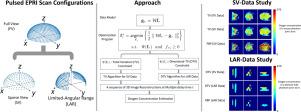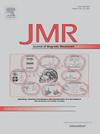脉冲电子顺磁共振成像中简化数据的精确图像重建
IF 1.9
3区 化学
Q3 BIOCHEMICAL RESEARCH METHODS
引用次数: 0
摘要
目的:研究和开发从稀疏视图(SVs)或有限角范围(LAR)采集的受试者数据中重建有效探针密度图像,然后获得氧浓度图像的算法,从而可能实现快速脉冲电子顺磁共振成像(EPRI)。在本文中,我们将有效探针密度图像简称为EPR图像。方法:将脉冲EPRI中SV或LAR数据的EPR图像重建问题制定为一个优化程序,该程序包括对EPR图像的总变差(TV)或方向电视(dtv)的约束。然后,通过求解各自的优化程序,分别开发了两种算法,即TV和DTV算法,用于从SV和LAR数据重建EPR图像。随后从重构的EPR图像中估计氧浓度图像。结果:通过对数字幻影的模拟数据以及物理幻影和小鼠模型的真实数据进行数值研究,我们展示了TV和DTV算法的潜力,分别从SV和LAR数据产生数值精确的EPR和氧浓度图像。结论:所开发的TV和DTV算法可以分别从脉冲EPRI的SV和LAR数据中获得数值精确的EPR和氧浓度图像。意义:这项工作可能会对最小化扫描时间的扫描设计产生见解,从而有可能实现快速脉冲EPRI的基础和临床前体内研究。本文章由计算机程序翻译,如有差异,请以英文原文为准。

Accurate image reconstruction from reduced data in pulsed electron paramagnetic resonance imaging
Objective:
We investigate and develop algorithms for reconstructing effective probe-density images, and then for obtaining oxygen-concentration images, from data of a subject collected at sparse views (SVs) or over a limited-angular range (LAR) for possibly achieving fast pulsed electron paramagnetic resonance imaging (EPRI). We refer to the effective probe-density image simply as the EPR image in the work.
Methods:
The reconstruction problem of EPR images from SV or LAR data in pulsed EPRI is formulated as an optimization program that includes a constraint either on the total variation (TV) or on the directional-TVs (DTVs) of the EPR image. Two algorithms, referred to as TV and DTV algorithms, are developed then for reconstruction of EPR images, respectively, from SV and LAR data through solving the respective optimization programs. Oxygen-concentration image is estimated subsequently from the EPR images reconstructed.
Results:
Using numerical studies with simulated data of a digital phantom and also with real data of a physical phantom and a mouse model, we demonstrate the potential of the TV and DTV algorithms that yield, respectively, from SV and LAR data, numerically accurate EPR and oxygen-concentration images.
Conclusion:
The TV and DTV algorithms developed can yield numerically accurate EPR and oxygen-concentration images, respectively, from SV and LAR data in pulsed EPRI.
Significance:
The work may yield insights into the design of scans with minimized scanning time, thus potentially enabling basic and preclinical in vivo studies with fast pulsed EPRI.
求助全文
通过发布文献求助,成功后即可免费获取论文全文。
去求助
来源期刊
CiteScore
3.80
自引率
13.60%
发文量
150
审稿时长
69 days
期刊介绍:
The Journal of Magnetic Resonance presents original technical and scientific papers in all aspects of magnetic resonance, including nuclear magnetic resonance spectroscopy (NMR) of solids and liquids, electron spin/paramagnetic resonance (EPR), in vivo magnetic resonance imaging (MRI) and spectroscopy (MRS), nuclear quadrupole resonance (NQR) and magnetic resonance phenomena at nearly zero fields or in combination with optics. The Journal''s main aims include deepening the physical principles underlying all these spectroscopies, publishing significant theoretical and experimental results leading to spectral and spatial progress in these areas, and opening new MR-based applications in chemistry, biology and medicine. The Journal also seeks descriptions of novel apparatuses, new experimental protocols, and new procedures of data analysis and interpretation - including computational and quantum-mechanical methods - capable of advancing MR spectroscopy and imaging.

 求助内容:
求助内容: 应助结果提醒方式:
应助结果提醒方式:


